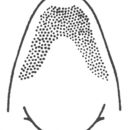en
names in breadcrumbs


Identification: Length 45-55 mm for males; 52-64 mm for females. Cone with pinched-in sides and a lower surface edged in black; stridulatory vein long and weakly swollen.
Habitat: Wet grassy areas; moist fields and roadsides.
Season: July–Sept.
Song at 25°C: A continuous series of lisps at a rate of 10 per second, sounding like a distant, fast-moving steam locomotive (to those who are old enough to remember). A distinctive song. At low temperatures, neighbors synchronize their lisps.
Similar Species: Neoconocephalus caudellianus is larger and its cone is thicker, with sides less distinctly pinched in. Neoconocephalus nebrascensis and N. lyristes have the lower surface of the cone wholly black or nearly so and stridulatory vein thicker and with more pronounced subsidiary veins.
More information: subfamily Copiphorinae, genus Neoconocephalus
References: Faure & Hoy 2000, Gwynne 1977, Libersat & Hoy 1991, Shaw et al. 1982.
"
"
Neoconocephalus ensiger, known generally as the sword-bearing conehead or swordbearer, is a species of conehead in the family Tettigoniidae.[1][2][3][4] It is found in North America.[1][5]
Neoconocephalus ensiger, known generally as the sword-bearing conehead or swordbearer, is a species of conehead in the family Tettigoniidae. It is found in North America.